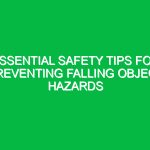Welcome to Our Toolbox Talk
Hello Team,
Today, we’re gathering for an important toolbox talk focused on a topic that impacts every one of us—Unsafe Conditions within the Health, Safety, and Environment (HSE) domain. Recognizing and addressing unsafe conditions is crucial to maintaining a safe working environment for everyone. By understanding these conditions, we can prevent accidents and ensure that our workplace remains safe and productive.
Understanding Unsafe Conditions
Unsafe conditions refer to any situation in the workplace that poses a risk of injury or harm to employees. These conditions can arise from various factors, including environmental Hazards, improper equipment usage, inadequate Safety Measures, and even human error. Addressing these conditions is not just a regulatory requirement; it’s a moral obligation we have to ourselves and our colleagues.
Why Focus on Unsafe Conditions?
Understanding and mitigating unsafe conditions is essential for several reasons:
- Preventing Accidents: The primary goal is to reduce the risk of accidents and injuries.
- Legal Compliance: Adhering to Safety Regulations helps prevent legal issues and fines.
- Boosting Morale: A safe workplace fosters confidence among employees, improving productivity and job satisfaction.
Common Unsafe Conditions to Watch For
Let’s take a closer look at some common unsafe conditions that can occur in our work environment:
1. Poor Housekeeping
Cluttered workspaces can lead to trips, slips, and falls. For example, if tools are left lying around, someone may trip over them. Ensure that all work areas are tidy and that spills are cleaned up immediately.
2. Inadequate Personal Protective Equipment (PPE)
Failing to use the appropriate PPE can expose workers to hazardous materials or environments. Always wear the necessary gear, such as gloves, helmets, and Eye Protection. If you notice someone without PPE, remind them gently about the importance of Safety.
3. Faulty Equipment
Using equipment that is damaged or malfunctioning can lead to serious accidents. Always inspect tools and machinery before use. If you identify a problem, report it immediately to your supervisor.
4. Inadequate Training
Employees must be trained to recognize and address unsafe conditions. For instance, if a new employee is unsure how to use a machine safely, that presents a risk. Ensure that training is thorough and that everyone understands the Procedures.
Identifying Unsafe Conditions: A Team Effort
Identifying unsafe conditions isn’t solely the responsibility of management; it requires teamwork. Each of us plays a role in maintaining safety. Here are some steps you can take:
- Be Observant: Keep your eyes open for any potential Hazards in your surroundings.
- Report Issues: If you see something unsafe, report it immediately to your supervisor or safety officer.
- Participate in Safety Meetings: Engage in discussions about safety practices and share your experiences.
For instance, if you notice a colleague working near an unguarded edge, speak up! Your proactive approach can prevent an accident.
Real-Life Scenarios: Learning from Mistakes
Let’s reflect on a couple of real-life incidents to understand the importance of addressing unsafe conditions:
Scenario 1: The Slippery Floor
In one company, an employee slipped on a wet floor that lacked proper signage. The result was a fractured wrist that required surgery. This incident could have been avoided with better housekeeping practices and proper signage warning of the hazard.
Scenario 2: The Missing Guard
Another example involved a worker who lost a finger while operating a machine that was missing its safety guard. This situation highlighted the need for regular equipment inspections and Maintenance to ensure all safety features are in place.
Best Practices for Mitigating Unsafe Conditions
Now that we’ve identified some common unsafe conditions, let’s discuss Best Practices for mitigating these risks:
1. Regular Safety Audits
Conduct regular safety audits to identify potential hazards. These audits can help ensure compliance with safety regulations and can highlight areas for improvement.
2. Training and Awareness Programs
Implement ongoing training and awareness programs to keep safety at the forefront. Regularly remind employees about the importance of recognizing and reporting unsafe conditions.
3. Encourage Open Communication
Foster an environment where employees feel comfortable discussing safety concerns without fear of reprimand. Open communication can lead to a safer workplace.
Regulations and Standards Related to Unsafe Conditions
Understanding the regulations governing unsafe conditions is vital. Compliance with OSHA (Occupational Safety and Health Administration) standards and other local regulations is non-negotiable. These standards mandate employers to provide a safe working environment and outline the necessary safety protocols.
Failing to comply can result in fines and increased scrutiny from regulatory bodies. Moreover, it places employees at risk, which is something we must all strive to prevent.
Engagement and Discussion
Before we conclude, let’s engage in a discussion. Here are some questions to consider:
- What are some unsafe conditions you’ve observed in our workplace?
- How can we improve our safety practices collectively?
- Do you feel comfortable reporting unsafe conditions? If not, what can we do to change that?
Your insights are valuable and can lead to actionable changes in our safety protocols.
Conclusion: Commitment to Safety
In summary, addressing unsafe conditions is an essential part of our daily operations. By being vigilant, communicating openly, and adhering to safety practices, we can prevent accidents and injuries. Remember, safety is everyone’s responsibility, and together we can create a safer workplace.
Thank you for your attention and your commitment to maintaining a safe working environment. Let’s continue working together to ensure that our workplace is as safe as possible.


